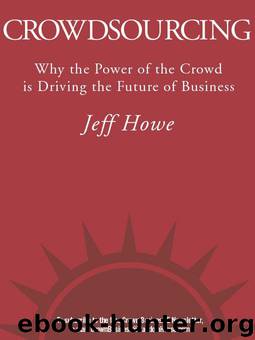Crowdsourcing: Why the Power of the Crowd Is Driving the Future of Business by Howe Jeff

Author:Howe, Jeff [Howe, Jeff]
Language: eng
Format: epub, mobi
Tags: Itzy, Kickass.to
ISBN: 9780307449320
Amazon: B001BAJ2LQ
Publisher: Crown Business
Published: 2008-08-18T04:00:00+00:00
Investing in the Future—Prediction Markets
In 1988, the civil rights activist Jesse Jackson shocked the nation by winning the Democratic primary race in Michigan, an outcome that neither polls nor political insiders had anticipated. At the University of Iowa, a handful of political scientists and economists were intrigued by the failure of the polls to predict Jackson’s victory and wondered if markets couldn’t do a better job of predicting the outcome of elections. Over the course of the next several months, and well in time for the general election between George H. W. Bush and Michael Dukakis, they created the Iowa Political Stock Market. Investors could buy up to $500 in securities that paid out according to the share of the popular vote each candidate received. Shares were priced between $0.01 and $1.00, and were paid out in full. If you snatched up Bush shares when they were running at 55¢, you’d have made 45¢ for every share you purchased.
By November the results came in. The average error among all the major exit polls in the general presidential election that year was 2.5 percent. Not bad. But the Iowa Political Stock Market did much, much better, predicting the outcome to within one-tenth of a percent. “While the laws of statistics govern opinion polls,” said Robert Forsythe, one of the market’s creators, “the invisible hand of Adam Smith makes political markets work.”
In fact the results were so impressive that the university renamed the experiment the Iowa Electronic Markets, or IEM, and began allowing trading in a range of future events, from elections in foreign countries to Google’s market capitalization to the price of Microsoft stock on a certain date to upcoming decisions by the Federal Reserve. In the two decades since trading opened, the IEM has consistently outperformed the best polls.
Why would this be so? Aren’t polls also tapping into the collective brain? Aren’t they, too, a form of crowdsourcing? The answer is yes, but that doesn’t make them as fine-tuned a predictive model as an information market like the IEM. Polls are crude instruments. The foolish and the wise alike get a single, equally weighted vote. A prediction market, on the other hand, privileges the wise by offering a financial return on his wisdom. The foolish have an equal incentive to stay away, a principle Scott Page has called “Fools Rush Out.”
Prediction markets offer considerable advantages over both polls and surveys as well as prognostications issued by experts, and they are becoming increasingly attractive to everyone from the media to private companies to government. While they might differ in scope and methodology, prediction markets are no different from any futures market. Traders bet on the likelihood of outcomes involving presidential elections, say, rather than involving pork bellies. The price of a security in one of these markets, in theory, reflects the collective prediction of how likely it is to occur.
Crowdcasting networks and prediction markets both utilize collective intelligence, but in very different ways. Prediction markets are essentially just machines used to aggregate information.
Download
Crowdsourcing: Why the Power of the Crowd Is Driving the Future of Business by Howe Jeff.mobi
This site does not store any files on its server. We only index and link to content provided by other sites. Please contact the content providers to delete copyright contents if any and email us, we'll remove relevant links or contents immediately.
Hit Refresh by Satya Nadella(9041)
The Compound Effect by Darren Hardy(8821)
Change Your Questions, Change Your Life by Marilee Adams(7640)
Nudge - Improving Decisions about Health, Wealth, and Happiness by Thaler Sunstein(7622)
The Black Swan by Nassim Nicholas Taleb(7016)
Deep Work by Cal Newport(6890)
Daring Greatly by Brene Brown(6451)
Rich Dad Poor Dad by Robert T. Kiyosaki(6414)
Principles: Life and Work by Ray Dalio(6230)
Playing to Win_ How Strategy Really Works by A.G. Lafley & Roger L. Martin(5939)
Man-made Catastrophes and Risk Information Concealment by Dmitry Chernov & Didier Sornette(5926)
Digital Minimalism by Cal Newport;(5669)
Big Magic: Creative Living Beyond Fear by Elizabeth Gilbert(5616)
The Myth of the Strong Leader by Archie Brown(5429)
The Slight Edge by Jeff Olson(5355)
Discipline Equals Freedom by Jocko Willink(5291)
The Motivation Myth by Jeff Haden(5158)
Stone's Rules by Roger Stone(5028)
The Laws of Human Nature by Robert Greene(5006)
